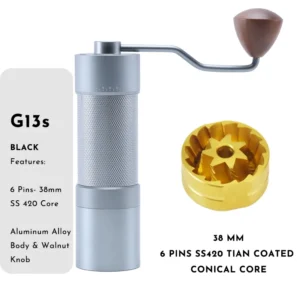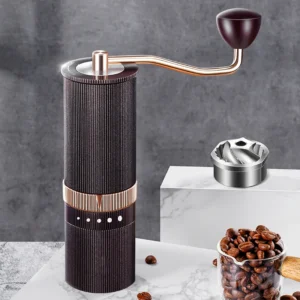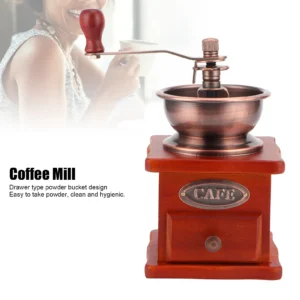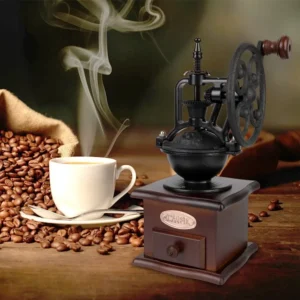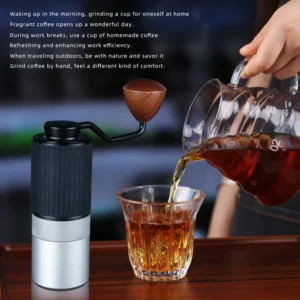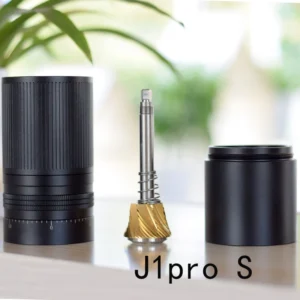Mechanical Coffee Grinder
Take control of your coffee with our manual burr grinders, crushing beans consistently for any brew from espresso to French press. Enjoy fresh, flavorful coffee quietly, at home or on the go.

Showing all 5 results
Manual Burr Mill, Manual Coffee Grinder Stainless Steel, Manual Coffee Mill Grinder, Mechanical Coffee Grinder
Price range: $127.26 through $130.32 Select options This product has multiple variants. The options may be chosen on the product pageHand Burr Grinder, Manual Coffee Grinder Stainless Steel, Manual Coffee Mill Grinder, Mechanical Coffee Grinder
$165.42 Select options This product has multiple variants. The options may be chosen on the product pageHand Crank Coffee Grinder, Manual Coffee Bean Grinder, Manual Coffee Mill Grinder, Mechanical Coffee Grinder
$65.36 Select options This product has multiple variants. The options may be chosen on the product pageHand Crank Coffee Grinder, Manual Coffee Bean Grinder, Manual Coffee Mill Grinder, Mechanical Coffee Grinder
$86.94 Select options This product has multiple variants. The options may be chosen on the product page
Showing all 5 results
Understanding Mechanical Coffee Grinders
Mechanical coffee grinders, also known as manual coffee grinders, are hand-operated devices that crush coffee beans between burrs without requiring electricity. These elegant tools work through a simple yet effective mechanism: as you turn the handle, it rotates the burrs that grind the beans to your desired consistency.
These timeless devices offer several distinct advantages:
- True portability: Take them camping, traveling, or to the office without needing power
- Whisper-quiet operation: Grind early morning coffee without waking the household
- Precise control: Adjust and feel the grinding process for perfect consistency
- Cool grinding: No heat transfer that can alter delicate flavor compounds
- Exceptional durability: Many quality models last decades with basic maintenance
- Mindful brewing ritual: The manual process connects you to your coffee preparation
While electric grinders offer convenience, manual grinders excel when you’re away from power sources, need silence, prepare small batches, or seek a budget-friendly quality option. The tactile satisfaction of hand-grinding fresh beans provides a sensory experience that pre-ground coffee simply cannot match.
The Science of Fresh Grinding
Coffee beans contain over 1,000 volatile compounds that create the complex flavors and aromas we love. Once ground, these compounds begin oxidizing immediately, dramatically decreasing coffee quality. The science is simple: grinding increases surface area exposure to oxygen, accelerating flavor deterioration.
Flavor Fact: Coffee begins losing 60% of its aroma compounds within 15 minutes after grinding.
This deterioration timeline is striking:
* 30 seconds after grinding: Optimal flavor preservation
* 30 minutes after grinding: Noticeable flavor loss
* Pre-ground coffee: Significant flavor compounds already lost
When you use a mechanical coffee grinder, you’re capturing these volatile compounds at their peak, allowing you to experience your beans’ full flavor potential. This freshness factor explains why specialty coffee shops always grind to order and why coffee enthusiasts invest in quality grinders before expensive brewing equipment.
Types of Mechanical Coffee Grinders
The world of manual coffee grinders offers several distinct variations, each with specific advantages:
Burr vs. Blade Grinders
While technically both mechanical, burr grinders crush beans between two abrasive surfaces for consistent particle size, while blade grinders randomly chop beans, creating uneven particles that extract inconsistently. For quality coffee, burr grinders are the only legitimate choice.
Conical vs. Flat Burr Hand Grinders
* Conical burrs: More common in manual grinders, these use less force to grind beans as they funnel through the cone-shaped grinding path
* Flat burrs: Provide extremely precise particle size distribution but require more force to turn by hand
Material Comparison
* Ceramic burr coffee grinders: Excellent heat resistance, very durable, and ideal for medium to coarse grinds typically used in pour-over, French press, and cold brew
* Steel burrs: Sharper cutting edges, faster grinding, and better suited for achieving fine espresso grinds
The outer construction varies widely from classic wood models to modern stainless steel, with each material affecting weight, durability, and aesthetic appeal.
Key Components & Quality Indicators
Understanding what separates premium mechanical grinders from basic models helps make informed purchasing decisions:
Critical Components to Evaluate:
* Burr quality: Precision-machined burrs with sharp edges
* Burr alignment: Minimal wobble for consistent grinding
* Adjustment mechanism: Clear, repeatable settings that don’t slip during use
* Bearing system: Metal bearings instead of plastic for stability
* Handle design: Comfortable grip with sufficient leverage
* Hopper capacity: Sufficient for your typical brewing amount
* Catch bin design: Minimal static and grounds retention
* Overall construction: Solid materials with tight tolerances
Premium mechanical grinders from Savor Suite feature stabilized burrs, double bearings to prevent wobble, and precision-machined components that maintain alignment even under pressure. These quality markers ensure consistent results cup after cup, year after year.
Matching Your Brewing Method to Grind Settings
Different brewing methods extract coffee optimally at specific grind sizes:
| Brewing Method | Grind Size | Visual Reference | Grinder Requirements |
|---|---|---|---|
| Turkish | Extra Fine | Powdered sugar | High-precision adjustment |
| Espresso | Very Fine | Fine sand | Stable burrs with fine adjustment |
| Moka Pot | Fine | Table salt | Consistent fine grinding |
| Pour Over | Medium-Fine | Sugar | Even particle distribution |
| Drip Coffee | Medium | Beach sand | Consistent medium grinding |
| French Press | Coarse | Sea salt | Clean coarse grinding |
| Cold Brew | Very Coarse | Peppercorns | Consistent coarse grinding |
The right grind size directly impacts extraction – too fine causes bitterness from over-extraction, while too coarse results in weak, sour coffee from under-extraction. A quality mechanical grinder allows you to dial in the perfect setting for your preferred brewing method.
Essential Features for Different User Needs
Mechanical grinders can be specialized for different coffee enthusiasts:
For Travelers & Outdoors Enthusiasts
* Portable coffee grinders with compact designs
* Lightweight yet durable construction
* Easy disassembly for cleaning without tools
* Smaller capacity (typically 20-30g) sufficient for individual servings
For Espresso Lovers
* Manual coffee grinders for espresso with micro-adjustment capabilities
* Heavy-duty construction to maintain stability during fine grinding
* Premium steel burrs for precision particle size distribution
* Larger handles for increased leverage when grinding fine
For Daily Home Brewers
* Comfortable ergonomics for regular use
* Capacity for 2-3 cups per grinding session
* Easy-to-clean components
* Consistent settings that maintain calibration
For Design-Conscious Users
* Premium materials like polished stainless steel or exotic woods
* Thoughtful aesthetic details
* Display-worthy craftsmanship
* Classic styling or modern minimalism
Grind Consistency: Why It Matters
Grind consistency is perhaps the single most important factor in achieving excellent coffee. When grounds have vastly different particle sizes, the smaller particles over-extract (creating bitterness) while larger particles under-extract (creating sourness) – simultaneously.
This inconsistency creates what coffee experts call “muddied flavors,” where distinct taste notes are masked by competing extraction levels. Precision manual grinders focus on creating uniform particle size through:
- Precisely machined burrs with clean cutting surfaces
- Minimal burr wobble during operation
- Strong stabilization systems to maintain alignment under pressure
- Quality bearings that reduce movement during grinding
The difference is immediately noticeable in the cup: consistent grinds produce clearer flavor notes, better sweetness, and smoother mouthfeel. While this matters for all brewing methods, it becomes critical for pour-over brewing where water flow and extraction time depend heavily on even particle distribution.
Care & Maintenance for Longevity
Quality mechanical coffee grinders can last decades with proper care:
- Regular cleaning: Disassemble and brush out coffee oils weekly for daily users
- Deep cleaning: Monthly removal of burrs to clean hidden areas
- Proper technique: Avoid forcing the handle or grinding non-coffee items
- Calibration checks: Periodically ensure your grinder maintains consistent settings
- Burr maintenance: Clean with specialized grinder cleaning tablets quarterly
For ceramic burrs, avoid dropping as they can chip despite their hardness. Steel burrs require keeping moisture away to prevent any corrosion. Most quality manual espresso grinders are designed for easy maintenance with simple disassembly.
Store your grinder in a dry place, and avoid extreme temperature changes that can affect calibration. With these simple steps, your mechanical grinder will deliver consistent results for years to come.
Frequently Asked Questions About Mechanical Coffee Grinders
How much effort is required for daily grinding?
Most quality grinders require 30-60 seconds of comfortable cranking for a single cup, depending on coffee bean hardness and grind fineness.
Can manual espresso grinders truly achieve consistent espresso-fine grinds?
Yes, premium manual grinders with steel burrs and stabilization systems produce espresso-quality grounds comparable to electric grinders costing much more.
How long does grinding take?
Typically 30-45 seconds for pour-over consistency (30g of beans), and 60-90 seconds for espresso fineness.
Are ceramic or steel burrs better?
Ceramic excels at heat resistance and longevity for medium/coarse grinds, while steel provides sharper cutting edges ideal for fine espresso grinding.
How often do burrs need replacement?
Quality burrs typically last 5-10 years for daily home use before requiring replacement, making them extremely cost-effective.
Can I easily switch between brewing methods?
Quality mechanical grinders feature clear adjustment systems that allow repeatable settings for all brewing methods from espresso to French press.


